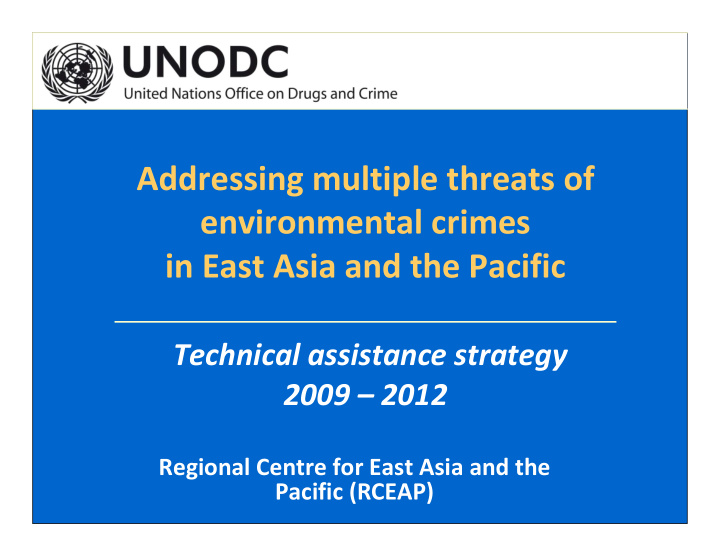



Addressing multiple threats of environmental crimes in East Asia and the Pacific Technical assistance strategy 2009 – 2012 Regional Centre for East Asia and the Pacific (RCEAP)
Structure of presentation 1. Mandate 2. Challenges 3. Intervention areas 4. Added value 5. Objectives
Structure of presentation 1. Mandate 2. Challenges 3. Intervention areas 4. Added value 5. Objectives
Mandate of UNODC • Resolution 16/1 of 2007 Commission on crime prevention and criminal justice: – International cooperation in preventing and combating illicit international trafficking in forest products, including timber, wildlife and other forest biological resources • Two instruments: – UNTOC – UNCAC
Structure of presentation 1. Mandate 2. Challenges 3. Intervention areas 4. Added value 5. Objectives
Environmental challenges in EAP • Forest area (2000 ‐ 2005): – Southeast Asia = ‐ 1.3% – Africa = ‐ 0.62% – World = ‐ 0.18% • Fish ‐ catch (2000 ‐ 2006): – Asia = 4.7% (Cambodia → 69.7%) – Oceania = 14.5% (PNG → 146%) – World = ‐ 3.9%
Environmental challenges in EAP • Wildlife illicit trafficking: – Species such as elephants, big cats, pangolins, wild cattle are threathened by extintion in some areas of SeA • Illegal trade of ODS and hazardous waste: – Growing trade due to weak law enforcement – Low risk and high profits
Consequences • Natural resources depletion (ecosystem impoverishment, climate change) • Slow human development (poverty, food insecurity) • State weakening (corruption, organized crimes) • Economic slowdown (less revenues, less investments)
Structure of presentation 1. Mandate 2. Challenges 3. Intervention areas 4. Added value 5. Objectives
Priority areas for RCEAP • Illegal logging and trade in timber ‐ national laws and CITES • Illegal trade in wildlife ‐ 1973 Washington Convention (CITES) • Illegal trade in ozone ‐ depleting substances (ODS) ‐ 1987 Montreal Protocol • Illegal trade in wastes including illegal transport and dumping of hazardous waste– 1989 Basel Convention and 1996 Protocol • Illegal, unregulated and unreported (IUU) fishing ‐ regional fisheries management organisations (RMFOs)
Structure of presentation 1. Mandate 2. Challenges 3. Intervention areas 4. Added value 5. Objectives
RCEAP’s added value • Law enforcement strengthening and border control – Border liaison office – Computer based training for LE officers – Legal advisory • Anti ‐ corruption and criminal justice – Technical assistance in AML and AC legislation – Global experience/partnership (e.g. StAR) – Best practices and international cooperation • Sustainable development – Reduction of illicit cropping in the Golden Triangle – Creation of alternatives for former poppy farmers – Community enpowerment
Structure of presentation 1. Mandate 2. Challenges 3. Intervention areas 4. Added value 5. Objectives
Regional Programme Framework 4. Drug demand 1. Illicit trafficking reduction Human Security: Reduction in illicit trafficking of Reduced drug abuse people, drugs, illicit natural Integrated resources and hazardous substances programmes of work will lead 5. HIV/AIDS 2. Anti- Health and Rule of to measurable corruption Development Reduction in HIV/AIDS Law transmission outcomes and Corrupt practices reduced results 6. Sustainable 3. Criminal livelihoods justice Reduction in serious crimes Reduced illicit opium production
Regional Programme Framework 4. Drug demand 1. Illicit trafficking reduction Human Security: Reduction in illicit trafficking of Reduced drug abuse people, drugs, illicit natural Integrated resources and hazardous substances programmes of work will lead 5. HIV/AIDS 2. Anti- Health and Rule of to measurable corruption Development Reduction in HIV/AIDS Law transmission outcomes and Corrupt practices reduced results 6. Sustainable 3. Criminal livelihoods justice Reduction in serious crimes Reduced illicit opium production
Reduction in illicit trafficking of Rule of Law people, drugs, illicit natural resources and hazardous 1. Illicit Trafficking substances Outcomes 1.4. Environmental 1.5. Smuggling Migrants 1.3. Drugs and 1.1 Border Control 1.2. Human Trafficking crimes Precursors Human trafficking Smuggling of migrants Improved border operations identified and Trafficking of illicit identified and effectively Trafficking of ATS and security effectively acted on natural resources and acted on other drugs identified and hazardous substances effectively acted on identified and Outputs 1.5 SMUGGLING MIGRANTS effectively acted on 1.1 BORDER CONTROL 1.2 HUMAN TRAFFICKING 1.3 DRUGS & PRECURSORS 1.5.1 Systems to generate, manage, analyze, report and 1.1.1 BLO mechanism 1.2.1 Legislative frameworks 1.3.1 Domestic legislation use migrant smuggling 1.4 ENVIRONMENT insitutionalized and meet international obligations harmonized with international information established and operational and standards instruments 1.4.1 A regional strategy in operational 1.1.2 Joint Port Control 1.2.2 Comparative data sets 1.3.2 Comparative data sets place to prevent and 1.5.2 BLOs’ mandates suppress trafficking in illicit Units established and on trafficking trends and on ATS and other drug broadened to cover crimes natural resources and operational country responses used by production and trafficking used related to irregular migration hazardous substances stakeholders to inform by stakeholders to inform 1.1.3 Airport specialist evidence based responses evidence based responses 1.5.3 Informed and capable 1.4.2 Effective response units frontline law enforcement environmental governance established and 1.2.3 Informed and capable 1.3.3 Informed and capable officers, prosecutors and policies and regulatory operational frontline law enforcement frontline law enforcement judges frameworks established officers, prosecutors and officers, prosecutors and and implemented judges judges 1.5.4 Research on irregular migration used as part of the 1.4.3 Informed and capable 1.2.4 Systems established for 1.3.4 Mechanisms established Bali Process law enforcement and quickly identifying and to promote cooperation assisting victims between criminal justice specialised officials agencies within and across 1.4.4 Mechanisms 1.2.5 Mechanisms established borders established to promote to promote cooperation cooperation between between criminal justice 1.3.5 Clandestine lab responsible agencies agencies within and across investigation teams established within and across borders borders and operational 1.4.5 Producers and 1.2.6 Corporate sector 1.3.6 Chemical industry organisations adopt codes of associations adopt codes of consumers effectively engaged in reducing conduct conduct on precursor diversion demand for illegal forest 1.2.7 Top-level political products engagement and commitment
Recommend
More recommend